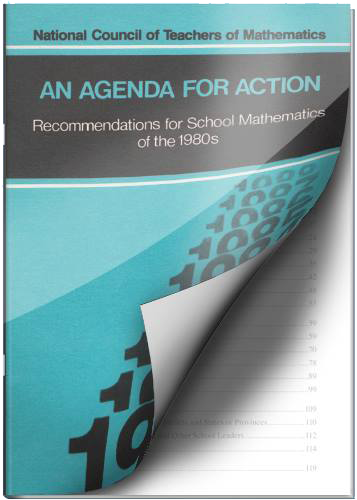View An Agenda for Action (1980s)
Copyright © 1980 by
The National Council of Teachers of Mathematics, Inc.

In the 1960s there was considerable ferment in mathematics curriculum and instruction. Although public attention was focused on the more visible attempts at program revision, we are aware two decades later that change was more apparent than real.
In the 1970s the concern of the public was directed toward problems evidenced almost exclusively in test scores. Schools have responded to this concern in a variety of ways, but a clear-cut and carefully reasoned sense of direction that looks toward the future has been lacking.
We recognize as valid and legitimate the role of public opinion in the determination of educational goals. But this philosophy is predicated on a well-informed public. Thus, the National Council of Teachers of Mathematics, as an organization of professional educators, has a special obligation to present its responsible and knowledgeable viewpoint of the directions mathematics programs should be taking in the 1980s.
These recommendations represent both realism and responsibility. They are realistic for their attention to hard data. We are fortunate to have more information about mathematics classroom practice than we ever have had. This useful information comes principally from a series of studies funded by the National Science Foundation and from two mathematics assessments of the National Assessment of Educational Progress.
The recommendations are responsible to the profession and to the public since they represent a very broad base of belief about objectives and priorities. The Council, funded by the National Science Foundation, conducted an extensive survey of the opinions of many sectors of society, both lay and professional. The project was called Priorities in School Mathematics (PRISM).
Such opinion surveys do not in themselves generate recommendations, but a professional organization, if it is to be responsible, must give them serious consideration as it develops its best-considered advice to society concerning future directions for educational programs.
These recommendations are not the end of our efforts but a beginning. They represent an agenda for a decade of action, and we call on all interested persons and groups to join us in a massive cooperative effort toward better mathematics education for all our youth.
April 1980
The Board of Directors
National Council of Teachers of Mathematics
Shirley A. Hill, President
Max A. Sobel, President-elect
Sarah M. Burkhart
LeRoy C. Dalton
Edgar L. Edwards, Jr.
Gail D. Lowe
Jane E. Martin
Douglas J. Potvin
James M. Rubillo
Jesse A. Rudnick
William A. Stannard
Catherine D. Tobin
James W. Wilson
June J.M. Yamashita
James D. Gates, Executive Director